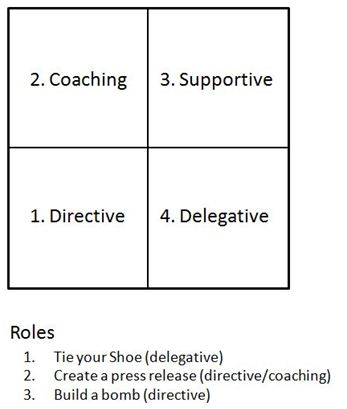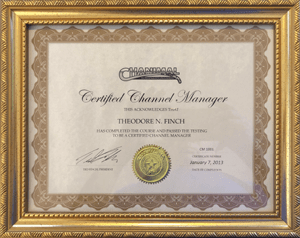Situational Leadership
We want to address management style first since it is critical that you understand why we are using a situational leadership model and will use a directive and coaching style to teach these concepts. But also so you’ll know that this initial style will soon change to supportive and delegative (where we leave you alone) as you master the concepts.
Knowing this will help you to be receptive to the new concepts, without being resentful that you’re receiving so much instruction (which you may or may not already know) when you may already consider yourself a professional (and most of you are). Please stay with us and you’ll understand the value of this approach as we level-set the entire team.
A Management Style
A proper management style can make or break an organization. Unfortunately, most of us have been the victim of a bad manager–in fact, it is usually the norm rather than the exception. It often involves a manager (CEO to the first level supervisor) who becomes impatient, appears disorganized and undisciplined, with knee jerk reactions (strategy of the day), who may spy on his team, hover and over-manage, or completely neglect his team–providing no help, insight or direction. Of course, then he blames his team and hangs them out to dry when they don’t perform to his expectations (whatever they are–since he never said).
We may observe that some managers are always directive–telling everyone what to do all of the time. Others are always delegative-they hire you and then do nothing–except when you mess up. Then they resort to “Seagull Management”–they fly in, crap all over the place, and fly out.

Unfortunately, for us to be successful we often have to find a manager that matches where we are in our career. We are fine with a directive manager when we are doing a new job (at least for a while–then we move on when we get better and no longer need help (and the company never benefits from our best performance)). We also do well with a delegative manager when we are seasoned, capable and motivated (when they let us do our job).
The problem occurs when we are in the middle of our career, or take on additional responsibility and are good at part of our job (the old part), but new at the other part. We may get caught in the middle, can’t manage expectations, and our good manager suddenly turns bad (since he doesn’t know how to fix the problem–so he flies in…).
Sometimes the employee is sent back down the ranks assuming he can’t handle the upper echelon–when it was really the manager’s problem, not the employees!
The problem. Most managers do not have a conscientious or systematic approach to managing or leading teams. They don’t know how to handle different situations and so they hack out an approach that is often based on their prior experience–often with bad managers, whom they emulate, rather than improve upon–like a child raised by an abusive parent (and continue to mess up the team).
Situational Leadership is The Solution
The solution. A manager needs to have a flexible management style that allows them to nurture new employees and provide additional help when existing employees take on new responsibilities, but they also should be able to delegate responsibilities entirely to capable and motivated employees–they need a flexible style. One such approach is called “Situational Leadership.”
Situational Leadership is a flexible management style that adjusts the management approach according to the employee’s capability and motivation with each of their current roles. Here’s how it works:
- Define the roles. First, the manager must define the roles of the employee. It is hard to hold anyone accountable unless they first know exactly what we expect. A job description that defines the responsibility and expectations for each role is essential. We also have to make sure there is no overlapping of roles and that the roles do not contradict the persons primary objective (i.e., sales doing HR, instead of concentrating on sales)–this is easier as the company grows and we have to specialize.
- Rate capability for each role. Next, the manager should rate an employee’s capability and motivation for each of their roles. They might receive a “1” for a new area they know nothing about and will need lots of direction and help, a “2” for an area they know something about but need coaching and review to master it, a “3” for an area they have experience and are competent with–but need support to build their confidence, and a “4” for an area where they are fully capable (often better then we are) and highly motivated, in which case they would be delegated the full responsibility.
- Apply a different style to each role. The manager would use a different style for each role–depending on their rating. For example, assume you had the following roles: A) Tie your shoes, B) Create a press release and C) Build a bomb. Where would you rate your ability with each role?
You would invariably be at a 4 (delegative) for tying your shoes. In fact, it would be an insult for a manager to ask you to re-tie your shoes (perhaps left over right, instead of right over left).
For creating a press release you may be between 1-2. You may have created an outline before, but you’ve never had to create a press release from scratch. You may need some direction to start (1 – Directive), plus you will want your manager or another person with more experience to review your work and make suggestions (2 – Coaching). Of course, once you’ve created several job descriptions you may not need any direction or coaching, but instead, you may need reinforcement (3 – supportive) to build your confidence, until you have mastered it (4 – Delegative).
For creating a bomb, you better be in the directive (1) quadrant or you’re probably doing the wrong job (perhaps the military might work?).
The Model
As you can see from the grid, there are four basic management styles:
- Directive. Give direction, samples, templates, and examples. This style is usually wanted and expected when you are doing something new and want help. It helps if the person directing knows how it should be done and what good results look like. Directive can be bad and even insulting when you are already experienced, capable and motivated.
- Coaching. The manager, or mentor, would review new work, provide edits and re-direction or additional samples. This helps the employee correct and refine their work until they get it right.
- Supportive. The manager would review and then validate that it is done correctly. This “pat on the back” helps build confidence.
- Delegative. The manager assigns a task to a capable and motivated employee and expects it done correctly. The manager only needs a copy of the completed work. The employee is fully capable and motivated and can do the task correctly (hopefully even better than those they report to). They have earned the right to be delegative.
The role of a good manager is the apply the correct style to each of the specific roles of your job. Over time there is only one management style–delegative, as the employee masters each role.
Safe Learning Style – Situational Leadership
Situational Leadership is a “safe” style since employees can risk-taking on new responsibilities (roles) without feeling that they will lose credibility in their overall job if they need help (show weakness (actually, humility and teachability is a good thing, not bad)). If this is the manager’s style, and an employee is new to a role, they can ask for and receive important direction. They can also expect coaching until they master it, then support until they own the responsibility (delegative).
The fact that an employee is seeking direction and coaching in a new role does not mean that they are considered incompetent in the other areas of there job where they may have earned the right to be delegative. It also means that if they have messed up in an area where they were previously delegative (forgot to lock the door to the office when you left), it only affects that one area.
The manager may get directive and ask for them to double-check all the doors before they leave–if they comply, the style goes right back to delegative. It also does not mean that the other 4-5 roles of their job are affected. As such, they only go backward in one area (so it can be fixed), but they retain credibility in their other roles.
The job of a good manager is to help their team members to get to delegative in ALL areas of their position using this situational leadership style. If an employee cannot move from directive to coaching to supportive to delegative, then they may not be a good fit for the job. In which case-specific roles may need to be adjusted, or they may have to do a different job altogether.
For example, one employee was an engineer by background. However, the division needed someone to correlate inventory levels with incoming sales (an operational role). The individual was given the assignment, lots of direction, but could not get it done on time and when done, it was often correct (they were not detailed enough). After numerous re-directs without success, the employee was reassigned to something else (back as an apps engineer–which they were superb at). Operations was just not a good fit, and the person could not progress to delegative, no matter how many times it was attempted.
A good manager also cannot do their job (do things that only they can do (like payroll, operations, etc.)) when they have to keep going back to directive or have to keep coaching–rather than progressing their team members to be delegative.

It’s Like Building A Road
The model can be likened to a team that is trying to build a road. If the team members are new and the only one with experience is the leader, then he must work on the ground and show them how to clear the land, prepare the surface, and pave the surface (tactics). However, they need someone who can see over the trees and make sure they are heading in the right direction (strategy). As he gives then direction, then coaches then build their confidence, he can get in his air balloon and go higher and higher–until he can see far enough to determine the direction. He may have to call down, “Turn 30 degrees to the left or you’ll run into the grand canyon.”
He can stay at a higher level and do things that only he can do (the strategic direction) so long as he can delegate building the road to his team. If they run into a rock, soggy ground, or a river (where they need a bridge), he can come down and help them through the directive, coaching and supportive stage until they know what to do and he can delegate in confidence. If he cannot get his team to the delegative stage, he can never concentrate on his strategic role. But this model shows how this can occur.
Similarly, as an employee gets new roles they should expect their manager to give them lots of direction, samples, templates, and then review their work with coaching, redirection, and examples (models). As they become capable, the manager should help build their confidence until they can do the job entirely on their own–delegative. They should never be afraid to admit that they need help–or they will never master all of their job or move to delegative. This should be the pattern for each role within their existing job, and also the pattern when they accept new responsibilities.
Everyone loves this situational leadership management style. It helps employees to learn their responsibilities thoroughly until they own the job, and it also gives them a chance to grow as they learn and master new responsibilities. Team members should be able to grow in a safe environment, and the company grows as competence increases.
Eventually, a good manager has a highly capable and motivated team and can spend time on team strategy, not tactics. As a manager’s effectiveness is recognized he often advances and receives new responsibilities–and everyone continues to advance and grow.
Consistency In the Ranks
Consistency is key. This Situational Leadership style is the primary management approach within Chanimal. It is important that everyone understand, master and expect it. It is something we do together with the team–not “to” the team (which is why it also explained in the sales manual and other places).
If a single manager (CEO to team leader) goes “Seagull,” then it disrupts the entire chain–and the confidence that this is a safe place to learn, grow, and improve dissipates quickly, team members start to close down and are not willing to take risks and move forward–which is essential for a fast-growing progressive team that expects to dominate our entire market space.
Learning to become a situational leader may take time. As a manager, you may “fly back to Seagull” at times and may need direction, coaching, and support until you master it. Everyone should be patient as we all grow and practice this style until it becomes ingrained in our culture–and creates the environment we all want.
Finally, please note that direction and coaching are part of our culture (to start). As we join Chanimal team members should expect and welcome lots of direction and help. They should also expect that they will be able to be more independent and self-actualized as they progress–none of us will want to be directive for long. So let’s all learn this situational leadership material quickly, remain teachable to new approaches, grow and we will all succeed together.
Review Questions
- What is Seagull Management?
- List from memory the four basic management styles.
- List five current areas of responsibility with your current job.
- Rate all five areas of your responsibility (above) and determine which management style would be used for each.
- Why is Situational Leadership considered a “safe” management style?
- What should you expect if you or your team members are new in a specific role?
- Why do we say this style is something we do with, not to your team?
Contact Info
Chanimal, Inc.
12109 Lake Stone Dr
Austin, TX 78738
512-263-9618
Click HERE to Email
Follow us on Facebook
NOTICE
I join a LOT of affiliate programs (connoisseur–like to see what they do), including Amazon, so there may be links throughout Chanimal.


